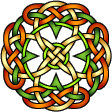|
If this warlike Border family
were ever so crabbed and contentious as to
deserve their popular description as 'the cappit
Kerrs', it was no doubt because of the long
contest for supremacy between the two great
houses of Cessford and Ferniehurst. Family
tradition relates that they were descended from
two brothers, without settling the important
point of which was the senior. Although for many
years the heads of each line alternated in the
office of Warden of the Middle March, their
rivalry brought death and disorder more than once
to the Border. The centre of the family's power
lay in lower Teviotdale, but various Kerrs
acquired lands in the counties of Peebles,
Haddington, Dumfries, Lanark, Stirling and even
Aberdeen in the reign of David II. While probably
of the same stock, all families of the name in
Scotland do not necessarily descend from the two
contending houses.
First of the name in Border
history was John Kerr, "hunter" at
Soonhope near Peebles, who emerges towards the
end of the 12th century. John Kerr of the forest
of Selkirk acquired Altonburn in 1358, and the
second Andrew of that place had a crown charter
of the lands and barony of Cessford in 1467. The
castle of Cessford - impressive even in ruin -
stood on the bank of a hill stream running into
the Kale water near Morebattle, on the northern
edge of the Cheviots. Meantime Thomas Kerr of
Smailholm, apparently a younger son of Cessford,
got Ferniehurst by marriage, with its castle (now
replaced by a later building) on the wooded banks
of the Jed. They were only six miles apart and
about the same distance from the English Border.
Family quarrels were not the
only cause of trouble among the Kerrs. A few
years before Flodden three Englishmen killed Sir
Robert Kerr, a former warden of the middle march,
while he was attending a march across the Border,
and his son tracked down one of the murderers and
gave him what was known as "Jeddart
justice". After Flodden some of the
Leddesdale clans put themselves under
Ferniehurst's protection, but in 1523 his castle
was taken by the English after a bold defence.
Cessford, who had worked as warden for peace and
co-operation with England, was killed by a
follower of Scott of Buccleuch in the attempt to
rescue James V from the Douglases. The two Kerr
houses sank their differences then, and again in
1545 so that their feud should not weaken the
defense of the Border against the English. But
Scotts and Kerrs continued to raid each other's
lands, and in 1552 Buccleuch was murdered in
Edinburgh by Cessford and some others. The Privy
Council managed to patch up the quarrel, with
Cessford promising to 'bury the past in oblivion
and live in amity in the future' with the Scotts,
and a solid phalanx of lairds of both names
agreed to ride together against trouble-makers,
'Scot with Ker and Ker with Scot'. Not until two
more Kerrs had been killed, including a laird of
Ancrum 'expert beyond others in the laws and
customs of the Borders', was the feud settled by
a mumble apology from Cessford and payment of
10,000 merks, followed by 'letters of slains' in
forgiveness from the murdered man's sons. As the
long-standing national rivalries also came to an
end, one of the last of the 'general bands'
against Border thieves and aggressors was signed
in 1602 by five Kerr lairds in Jedburgh and two
more in Peebles.
Union with England under one
crown reduced the importance of Border clans and
groups, but by now the principal Kerrs were
influential magnates. Two of them followed the
court to London, and royal flavour was reflected
in a series of honours - Cessford was made Lord
Roxburghe (1600), earl (1616) and duke (1707),
while Ferniehurst became Lord Jedburgh (1622) and
through a cadet branch Earl (1631) and Marquess
(1701) of Lothian.
|



